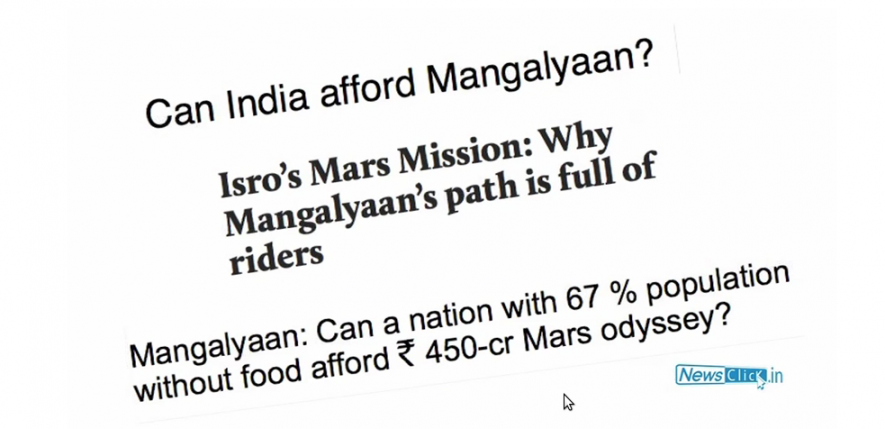India's Mission to Mars
India has become the sixth country in the world to launch space mission to Mars. On November 5, it launched the Mars Mission using the ISRO’s tried and tested work horse, the PSLV (Polar Satellite Launch Vehicle) rocket. Newsclick speaks to D. Raghunandan of the Delhi Science Forum to discuss the implications and limitations of this mission. Raghunandan feels it would have been more useful if the mission was launched using the much more powerful GSLV (Geo-Stationary Launch Vehicle) rocket that could carry a larger satellite with more instruments.

Transcript:
Rishab Bailey (R.B): Hello and welcome to Newsclick. Earlier this week, India became the 6th country in the world to launch a space mission to Mars. Despite the extraordinarily low cost of this mission, pegged at about 75 million US dollars, the project has been criticized by many who question how such projects can benefit India. To discuss this issue we have with us Dr. D. Raghunandan of the Delhi Science Forum. So Raghu, Why has India launched this mission and what is it supposed to accomplish?
D. Raghunandan (D.R): Well, the proclaimed intention of ISRO was to develop technologies, which will enable inter-planetary space exploration and to conduct a set of experiments around mars. You would recall that a couple of years ago we had sent a craft to the moon. So clearly India has embarked on a journey of conducting some research in outer space. That was the stated intention of ISRO but this particular mission given its configuration has a slightly more limited set of objectives, which are basically to demonstrate the technology to be able to reach Mars and to conduct a small set of experiments which will yield a little bit in terms of the science.
R.B: Do you think it’s a binary choice India faces between funding space programmes and social welfare programmes? A lot of the criticism especially in the western media is focused on the fact that India should not be pursuing such programmes when there are so many people without access to health care, sanitation and so on. What are your thoughts?
D.R: Unfortunately it’s not just the western media, which has said that, we have had several commentators within India and normally progressive commentators concerned about social concerns who have also taken similar positions. My feeling is that this is a completely mistaken position. As far as the western commentators are concerned, we have been hearing this since the dawn of independence in India. When Britain, the United States, other European countries essentially neo-colonial powers said that why does India want to construct steel plants, why does it want make cement, why does India want to set up scientific establishments? India is a poor country and it should think of feeding its poor. We have heard all these arguments before.
I’m a bit more surprised at the Indian commentators saying this, for two reasons. One is that the outlay of 75 million US dollars on this programme is actually very small in comparison with what the other countries are spending. For example the U.S is going to send a very similar spacecraft to mars next week at about 6 times the cost India is spending on this mission, which is about 450 crores. Whereas every year India spends more than 1 lakh crores on poverty alleviation and rural development programmes. So this not even a drop in the ocean.
If we want to understand why India has not been able to alleviate of poverty and improve health and sanitation, we should really be looking elsewhere. We should be looking at political economy, implementation of programmes.
R.B: So what are your criticisms of this programme given the fact that sending a mission to mars is technically very difficult and that India is one of the first countries to have done it.
D.R: Well, we haven’t done it yet in the sense that we have to wait until September next year to find out whether our spacecraft starts orbiting mars. There have been about 50 attempts at sending spacecrafts to mars out of which only 21 have actually succeeded. A couple of years ago when the Chinese sent a spacecraft on a Russian launcher, it unfortunately could not get out of earth’s gravity. When the Japanese tried it a few years ago, the spacecraft crashed into mars. So even when you get as close to the planet as that, we don’t know the whether we are going to succeed or not. So we should wait till September next year to proclaim success.
This particular mission in my opinion is a sub-optimal one as the stated objective is to demonstrate technology and there’s no great technology to demonstrate in this particular mission. If we had sent this on the Geo-stationary Launch Vehicle (G.S.L.V), which is a more powerful rocket, then we would have demonstrated something substantial than the Polar Satellite Launch Vehicle (P.S.L.V) that we have launched now. The P.S.L.V is India’s workhorse used by India to launch low earth orbit satellites useful for weather sensing remote sensing applications and so on. Whereas the high earth orbit satellites, which are we what require for communications, television, telephony, we are yet not able to send our on satellites on board our own rockets. We are dependent on the Europeans for that.
Plus we are missing out on a very important and growing commercial market in the world where given out low cost launch capability, we would have been able to gain a lot of market share. If we had used the G.S.L.V then we would have proved that we have a heavy reliable launch vehicle, which can put satellites into high earth orbit. With the P.S.L.V we have only demonstrated for the 25th time that we have a rocket that can put satellites into low earth orbit and that has limited commercial applicability.
And since we have launched a very light rocket we have not been able to send a very heavy payload i.e. the scientific instruments, which is just about 12 kilograms useful to carry out rather simple experiments. So the science yield will not be as good as it could have been.
To put it briefly, India when it succeeds, would have demonstrated that we can reach mars and I think that’s about it.
R.B: Do you think this launch will act as a spur to a space race between India And China as many people are commenting?
D.R: Last year when the Prime Minister made the announcement fro the Red Fort about this mission to mars, both the political leadership and ISRO knew that we didn’t have the G.S.L.V ready. So they knew that this was a limited yield mission. The fact that we would be able to reach mars from a 2013 launch and if we miss this opportunity we will have to wait till 2016 and the next window would be 2018. One of the factors that India must have taken into account is ‘let’s at least do something which can showcase India’s space and technological capabilities’. May be one of the factors also would have been ‘let’s do it before China does’.
I think this is more about bragging rights than about a real space race. Frankly speaking, China is way ahead of India right now in terms of launch capability and we should not even be comparing ourselves with Japan in terms of scientific and technological capabilities.
R.B: Okay that’s all the time we have today on Newsclick. Thank you Raghu for joining us.
D.R: Thank you.
Get the latest reports & analysis with people's perspective on Protests, movements & deep analytical videos, discussions of the current affairs in your Telegram app. Subscribe to NewsClick's Telegram channel & get Real-Time updates on stories, as they get published on our website.























